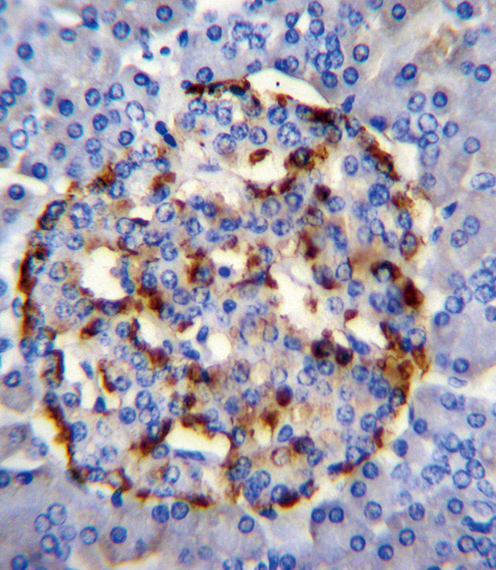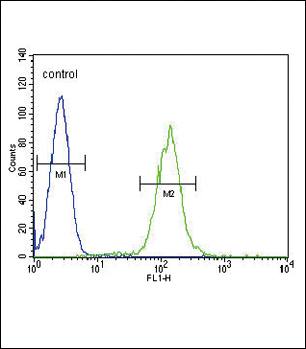PLA2G2D Antibody (C-term)
Affinity Purified Rabbit Polyclonal Antibody (Pab)
- SPECIFICATION
- CITATIONS
- PROTOCOLS
- BACKGROUND

Application
| WB, IHC-P, FC, E |
|---|---|
| Primary Accession | Q9UNK4 |
| Other Accession | NP_036532.1 |
| Reactivity | Human |
| Host | Rabbit |
| Clonality | Polyclonal |
| Isotype | Rabbit IgG |
| Calculated MW | 16546 Da |
| Antigen Region | 105-131 aa |
| Gene ID | 26279 |
|---|---|
| Other Names | Group IID secretory phospholipase A2, GIID sPLA2, sPLA2-IID, PLA2IID, Phosphatidylcholine 2-acylhydrolase 2D, Secretory-type PLA, stroma-associated homolog, PLA2G2D, SPLASH |
| Target/Specificity | This PLA2G2D antibody is generated from rabbits immunized with a KLH conjugated synthetic peptide between 105-131 amino acids from the C-terminal region of human PLA2G2D. |
| Dilution | WB~~1:1000 IHC-P~~1:10~50 FC~~1:10~50 E~~Use at an assay dependent concentration. |
| Format | Purified polyclonal antibody supplied in PBS with 0.09% (W/V) sodium azide. This antibody is purified through a protein A column, followed by peptide affinity purification. |
| Storage | Maintain refrigerated at 2-8°C for up to 2 weeks. For long term storage store at -20°C in small aliquots to prevent freeze-thaw cycles. |
| Precautions | PLA2G2D Antibody (C-term) is for research use only and not for use in diagnostic or therapeutic procedures. |
| Name | PLA2G2D |
|---|---|
| Synonyms | SPLASH |
| Function | Secretory calcium-dependent phospholipase A2 that primarily targets extracellular lipids, exerting anti-inflammatory and immunosuppressive functions (PubMed:10455175, PubMed:10681567). Hydrolyzes the ester bond of the fatty acyl group attached at sn-2 position of phospholipids (phospholipase A2 activity) with preference for phosphatidylethanolamines and phosphatidylglycerols over phosphatidylcholines (PubMed:10455175). In draining lymph nodes, selectively hydrolyzes diacyl and alkenyl forms of phosphatidylethanolamines, releasing omega-3 polyunsaturated fatty acids (PUFAs) such as eicosapentaenoate and docosahexaenoate that are precursors of the anti-inflammatory lipid mediators, resolvins (By similarity). During the resolution phase of acute inflammation drives docosahexaenoate-derived resolvin D1 synthesis, which suppresses dendritic cell activation and T-helper 1 immune response (By similarity). May act in an autocrine and paracrine manner (By similarity). Via a mechanism independent of its catalytic activity, promotes differentiation of regulatory T cells (Tregs) and participates in the maintenance of immune tolerance (By similarity). May contribute to lipid remodeling of cellular membranes and generation of lipid mediators involved in pathogen clearance. Displays bactericidal activity against Gram-positive bacteria by directly hydrolyzing phospholipids of the bacterial membrane (By similarity). |
| Cellular Location | Secreted. |
| Tissue Location | Highly expressed in pancreas and spleen and less abundantly in colon, thymus, placenta, small intestine, and prostate |

Thousands of laboratories across the world have published research that depended on the performance of antibodies from Abcepta to advance their research. Check out links to articles that cite our products in major peer-reviewed journals, organized by research category.
info@abcepta.com, and receive a free "I Love Antibodies" mug.
Provided below are standard protocols that you may find useful for product applications.
Background
Transposase-derived protein that may have nuclease activity (Potential). Does not have transposase activity.
References
Davila, S., et al. Genes Immun. 11(3):232-238(2010)
Segat, L., et al. Vaccine 28(10):2201-2206(2010)
Igarashi, A., et al. Respiration 78(3):312-321(2009)
Lessig, J., et al. Asian J. Androl. 10(6):829-836(2008)
Lindbom, J., et al. Inflammation 29 (2-3), 108-117 (2005) :
If you have used an Abcepta product and would like to share how it has performed, please click on the "Submit Review" button and provide the requested information. Our staff will examine and post your review and contact you if needed.
If you have any additional inquiries please email technical services at tech@abcepta.com.













 Foundational characteristics of cancer include proliferation, angiogenesis, migration, evasion of apoptosis, and cellular immortality. Find key markers for these cellular processes and antibodies to detect them.
Foundational characteristics of cancer include proliferation, angiogenesis, migration, evasion of apoptosis, and cellular immortality. Find key markers for these cellular processes and antibodies to detect them. The SUMOplot™ Analysis Program predicts and scores sumoylation sites in your protein. SUMOylation is a post-translational modification involved in various cellular processes, such as nuclear-cytosolic transport, transcriptional regulation, apoptosis, protein stability, response to stress, and progression through the cell cycle.
The SUMOplot™ Analysis Program predicts and scores sumoylation sites in your protein. SUMOylation is a post-translational modification involved in various cellular processes, such as nuclear-cytosolic transport, transcriptional regulation, apoptosis, protein stability, response to stress, and progression through the cell cycle. The Autophagy Receptor Motif Plotter predicts and scores autophagy receptor binding sites in your protein. Identifying proteins connected to this pathway is critical to understanding the role of autophagy in physiological as well as pathological processes such as development, differentiation, neurodegenerative diseases, stress, infection, and cancer.
The Autophagy Receptor Motif Plotter predicts and scores autophagy receptor binding sites in your protein. Identifying proteins connected to this pathway is critical to understanding the role of autophagy in physiological as well as pathological processes such as development, differentiation, neurodegenerative diseases, stress, infection, and cancer.




